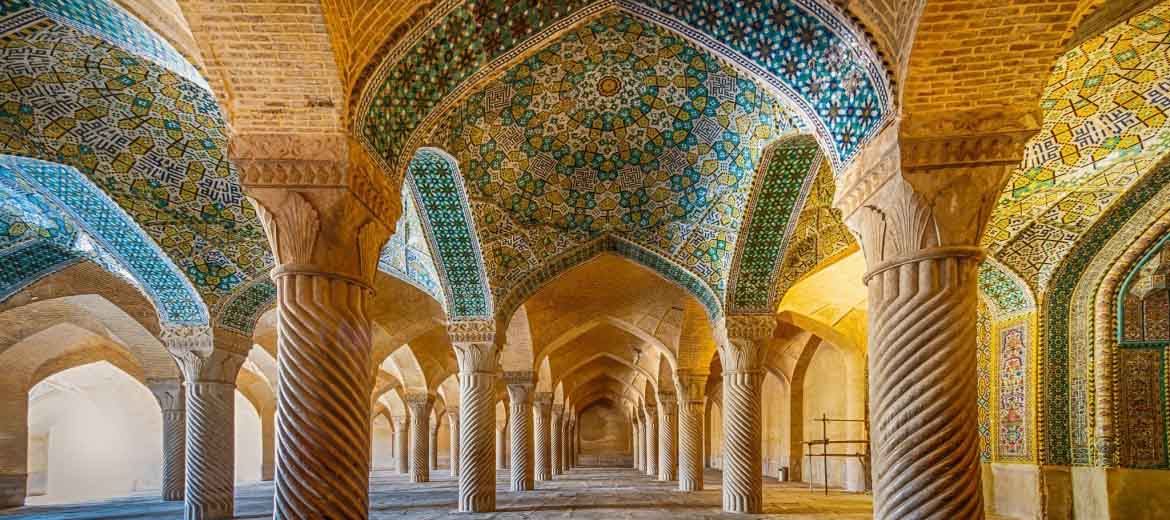Vakil Mosque is one of the top Attractions that you can visit while you are in Shiraz. The special architecture of this mosque has been a subject of different mosque photography. For Its incredible detailed Prayer hall in floral design and special spiral columns, it is a fine example among Iran mosques.
Significance of Iran Mosques & Vakil Complex
The importance of Iran mosques is that they mirror a mixture of Iranian and Islamic architecture. Accordingly, all mosques have several common characteristics. Historic mosques, holy shrines, and contemporary mosques can be seen in each major city of Iran. Historic mosques have been built as a part of a complex along with Bazaars and Bath Houses. The complex would have acted as the meeting point of social and cultural interaction. Similarly, in Shiraz, there is the Vakil Complex which includes the Vakil Mosque, the Vakil Bazaar and the Vakil Bath House. In the same way, Jameh mosque of Yazd, Jameh mosque of Isfahan, and Jameh mosque of Na’in were built for the same purpose in their cities.
What makes Iran mosques such as Vakil Mosque different?
Iranian-Islamic art has been reflected in the symbolism of the architecture of Iran mosques. The patterns, calligraphies, and tones of colors are all in favor of showing the sacredness and different aspects of religion. One of the main aspects is unity. What makes Iranian mosques different from mosques across the world is that these mosques were built upon Iranian culture, principles and even geography. All being said, let’s read on about history, architecture and more about Vakil Mosque of Shiraz.
The History that shaped the present Vakil Mosque
Vakil mosque, as a late 18th century work of art, was constructed during Zand dynasty. The mosque was built under the orders of Karim Khan of Zand. During his reign, he made Shiraz the capital of the country. As a result, he ordered the construction of many astonishing landmarks. In the same way, the Vakil Complex was one of these architectural projects. In fact, Vakil Mosque was considered as one of the most important religious buildings of the era.
According to several documents, Vakil Mosque has been reformed and restored through some stages during the years. It has been mentioned that the mosque was constructed on the site of an earlier mosque belonging to Safavid era. Vakil Mosque was essentially completed in 19th century, during the Qajar era. The mosque was damaged after earthquakes but it was restored and repaired afterwards. The restorations are mentioned on several inscriptions in the mosque. Despite all Qajar restorations, the mosque can be easily distinguished as a Zand masterpiece by its style and architectural elements.
Architectural highlights of Vakil Mosque
This Attraction holds a unique collection of architecture and design. The carvings of stones, inscriptions and specially the masterfully carved columns of Vakil Mosque will catch your eyes. Fine works of calligraphy can be seen in different parts of Vakil Mosque. The elegant patterns of the lavish tilework and its colors were designed to reflect beauty in the simplest way possible. Interestingly, Vakil Mosque, unlike many major mosques in Iran, has no dome and no large minarets.
-
The Portal & the Courtyard
You can enter the mosque through the northern entrance which is adorned with eye-catching moqarnas (a form of Vault in Islamic architecture). Behind the entrance is a corridor that has passages which lead you to the courtyard. Interestingly, through this passage, the courtyard is angled toward Qibla (the direction of Ka’ba) while the entrance stands in harmony with the outside complex.
-
Outstanding Verandas
Once in the courtyard, there are two iwans (large vaults) facing each other. The one on the north is called Morvarid iwan meaning the pearl iwan. This iwan and the southern iwan are designed with stunning type of tilework called seven-color tiles.
-
Inside the Prayer Halls
Vakil mosque has two Shabestans (Prayer hall). The southern Shabestan, with its 48 carved monolithic columns, is the highlight of the mosque. The remarkable patterns of the arches lead you to the altar. There is a special marble pulpit placed next to the altar. The other Shabestan which is the winter prayer hall is located on the eastern side. The arches continue on the western side of the mosque.
When and where can I visit Vakil Mosque?
Vakil mosque is open from 8:30 AM to 7 PM. We recommend visiting this attraction during daylight. Now, where is Vakil Mosque located? As mentioned before, Vakil mosque is a part of a bigger complex including Vakil Bazaar and Vakil Bath House. It is located on Taleqani Street of Shiraz.
If you want to get there by Shiraz Subway, you should get off at Shahrdari Metro Station. After walking southward, you will reach Piroozi Street. From there, you should turn left on Farhang Avenue to find Taleqani Street. You can find the beautiful entrance of Vakil Mosque just across from some outdoor cafes.
Attractions near Vakil Mosque
Aside from Vakil Bazaar and Vakil Bath House that are located right next to the mosque, you can visit some other attractions. Pars museum and Khan Madrasah, the largest theological instruction in Shiraz, established for the Iranian philosopher Mullah Sadra, are located nearby. Arg of Karim Khan (Castle) is also located within walking distance of Vakil Mosque. While you are in Shiraz you can visit the famous Nasir-ol-Molk Mosque, also known as the pink mosque.


Comment (0)